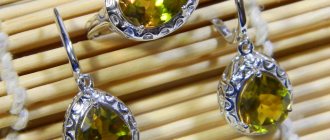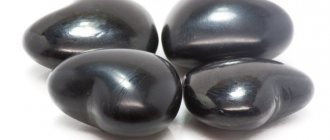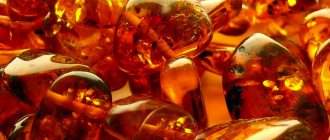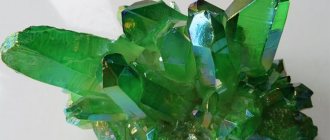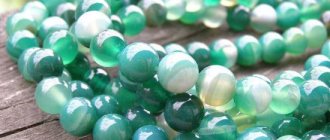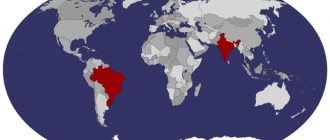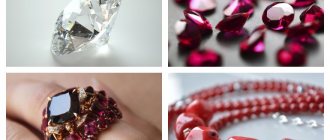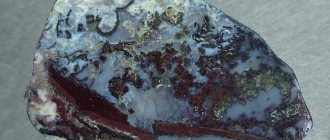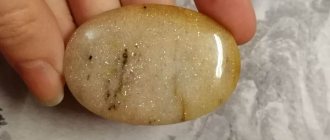A diamond is a diamond that has been processed by jewelers. The stone got its name from the French word “brilliant,” which means “brilliant, sparkling.” This is one of the most expensive gems in the world. Diamonds have become famous thanks to references in literature and art.
What is a diamond
A diamond is a diamond stone that has been given a special shape that fully reveals its beauty. A diamond’s special property is its fluorescence—its ability to glow brightly in ultraviolet light.
The jewel is used to make jewelry. The stone has an unusual shine, and in the rays of light it simply “lights up” and shimmers with different colors of the rainbow.
Read the article for more details on the difference between a diamond and a rough diamond.
Varieties and color scale
A classic diamond is colorless and transparent. But there are also fancy colors that are less common and more expensive:
- black;
- brown or cognac;
- red;
- pink;
- yellow;
- violet;
- green.
Stones acquire multi-colored colors due to the inclusion of iron, boron, and nitrogen atoms in the crystal lattice. This happens under the influence of high temperature and pressure.
The rarest ones are black, pink and blue diamonds. They are highly valued and are usually found only in private collections.
The purity of the stone is of great importance for the final cost. It is determined by the absence of defects and the transparency of the crystal. The purity is enhanced by the processing; the higher the quality, the purer the crystal.
A white diamond without defects is called a “pure water diamond.” If you put it in water, it is absolutely invisible. The most famous of these stones is the Cullinan Diamond. It was originally the largest diamond, weighing 3,106 carats. In 1906, the famous jeweler Joseph Ascher, after studying the stone for many months, split it into many fragments. 9 large and 96 small diamonds were made from diamond.
Turning a Diamond into a Diamond
The ancient Hindus endowed diamond with supernatural powers. They believed that this stone organically combined water, air, earth, wind and energy, which imparted to the mineral its fantastic beauty and attractiveness.
Natural diamonds rarely have any shine. Without cutting, it does not look very attractive, although it is incredibly expensive. A cut diamond turns into a full-fledged diamond, which can be used to make rings, bracelets, tiaras, necklaces and women's earrings.
The largest processed diamonds become masterpieces of private collections and museum exhibits, which millions of people want to admire.
Diamond cutting is an extremely complex and time-consuming process, which only the most experienced jewelry craftsmen are allowed to undertake. The appearance of the slightest defect can significantly reduce the cost of a diamond, and preserving even a hundredth of a carat can increase the cost of a large stone several times.
History and origin
The first diamond was mined more than 3,000 years ago in India. It immediately began to have a high value, but the stone was not processed until the Middle Ages. The old name for the jewelry is diamond, adamant.
The diamond began to be valued as a gemstone in the 15th century. He attracted the attention of King Charles VII's favorite, Agnes Sorel. The fashion for diamond jewelry was quickly adopted by the ladies of the court, and then by other countries.
Diamonds have always been participants in historical and literary events:
- The Great Mughal - a 767-carat diamond was used to create a rose-shaped diamond, owned by Shah Jahan, the ruler of the Mughal Empire;
- Golden Jubilee - a brown diamond weighing 545 carats, presented to the King of Thailand for the anniversary of his reign;
- Orlov is the largest copy of the Kremlin Diamond Fund;
- Sancy - purchased by the Louvre for a million francs;
- Kohinoor - adorns the diamond crown belonging to the Queen of England;
- Hope is a diamond with a curse, all its owners experienced misfortune, now the stone worth 350 million dollars is kept in the Smithsonian Institution;
- The Heart of the Ocean is the famous blue diamond from the film Titanic, which belonged to the heroine of the film Rose.
Additionally, read the article about famous diamonds.
Many copies are presented in the Amsterdam Museum. Here you can see all the stages of diamond processing, as well as works of art inlaid with diamonds. The Diamond Museum in the Belgian city of Bruges also displays many pieces, mostly of historical value.
One of the rare Soviet orders was encrusted with 180 diamonds - the Order of Victory. A total of 22 copies were made, 19 of them were awarded. Only particularly distinguished commanders of the USSR were nominated for the award.
In addition to the topic of gemstone history, watch the video:
"Radiant" and "Usher"
The most popular type of cutting in recent years has been the “Radiant” method, invented by Dutch jewelers about 30 years ago. This diamond cutting method combines the traditional Emerald and Princess shapes.
The gemstone resembles a square with beveled corners and can be more securely mounted in a setting. This type of cut thickens the color slightly and is better suited for multi-colored diamonds.
The square shape of the Asscher cut was invented by Belgian jewelers, who used it to process stones of ideal purity.
In most cases, the ratio of the length and width of the sides of the square is 1 to 1, but there may be some minor deviations. The shape is very popular because it is somewhat reminiscent of medieval jewelry.
Stone processing
Diamonds began to be processed almost immediately after their discovery. The initial processing was minimal - one face of the crystal was ground off and then polished. In 1465, the Burgundian jeweler Van Berkem cut the crystal in the shape of a rose. Since then, jewelers have constantly developed new techniques to make the perfect diamond.
The standard number of facets in diamonds of the highest standard is 57. This number was determined through many physical and mathematical calculations. It is believed that 33 facets at the top of the diamond and 24 facets at the bottom maximize the brilliance and play of light.
The round diamond shape with 57 facets is the most common. This treatment is used for stones weighing at least 0.05 carats. Smaller crystals are cut into 17 facets. A clear structure of the appearance of faceted stone has been determined:
- two main parts - the crown and the pavilion, separated by a girdle;
- the largest face is located in the crown, called the platform;
- 8 wedges extend down from the platform and come into contact with the 8 main faces of the crown;
- 16 wedges extend upward from the girdle;
- the pavilion contains 24 wedges and has an elongated shape;
- the lowest point of the stone is called the culet.
In the second half of the 20th century, new methods of cutting diamonds were developed. They are mainly used for large stones weighing more than 1 carat. The true cutting methods for diamonds include round, royal and majestic shapes. The last two are square in shape. There are fantasy ways:
- marquis;
- princess;
- pear;
- heart;
- oval;
- baguette;
- emerald.
These methods are used depending on the initial shape of the diamonds and the needs of the customer.
Rhodium plated diamonds are stones coated with a thin layer of rhodium. Metal increases the strength of the diamond, protects it from damage, and extends its service life.
Watch a program about how these precious stones are produced:
Main cutting stages
Jewelers first of all examine the rough and polished diamond that has fallen into their hands, identifying natural defects, as well as violations of the technology of processing diamonds into polished diamonds that need to be eliminated.
First of all, cracks are identified during diamond processing, along which the mineral must be separated. Only after this can the diamond be properly cut and shaped to be used in jewelry production.
Subsequently, the edges are applied and the stone is polished, for which special equipment and diamond powder are used, which makes it possible to grind the hardest stone in the world.
It should be understood that the larger the diamond, the more weight it will lose during cutting due to the obligatory presence of cracks and defects.
High-quality processing of a precious stone takes a lot of time, and you can read more about it in the article “How cutters process diamonds.”
What are diamonds made of?
A real diamond is made from natural diamond. It is a mineral formed in nature from carbon atoms under the influence of high pressure and temperature. Diamonds are mined from their deposits, so the cost of natural jewelry is high.
Synthetic diamonds are produced artificially by applying pressure and temperature to carbon. A technique has been developed for making diamonds from human ashes.
The ashes formed after cremation consist of organic substances, including carbon. It is extracted from the dust and converted under pressure into an artificial diamond. It is then made into a diamond.
We recommend watching a short film about diamond production:
Read the article: how to make a diamond yourself.
Rose cut
This is one of the most ancient types of gemstone processing, which consists of an almost uncut base, and the upper part of the Rose diamond consists of 24 facets, designed in the form of triangular facets.
When viewed from above, this type of diamond resembles an ordinary rose bud.
This type of gemstone treatment belongs to the old-fashioned Art Deco style, and in modern interpretation is often called "Rosetta".
Most often, such stones, the size of which is up to 2 carats, are inserted into everyday women's jewelry. This processing method is not suitable for smaller diamonds.
How to distinguish a real diamond from a fake, methods
There are no diamond analogues, that is, precious stones with identical properties. Artificially made stones are used to make jewelry, which look very similar to diamonds.
Such stones are much cheaper and do not have the appropriate certificates. Although they are almost indistinguishable from diamonds in appearance, there are several ways to distinguish diamonds from cubic zirconia or moissanite.
Professional methods
Jewelers evaluate authenticity using complex physical and chemical methods. Thermal conductivity and light reflection, density and mass of the stone are measured. Under a microscope, the presence of the smallest defects and inclusions is determined. The stone is illuminated under ultraviolet light.
Traditional methods of verifying the authenticity of a stone
You can evaluate the authenticity of a diamond at home:
- if you breathe on a diamond, it will not fog up;
- fat leaves a wide strip on natural stone, and collects in drops on moissanite or cubic zirconia;
- if you drag the edge of a diamond across the glass, a scratch will remain;
- Diamonds sink in water, floating pebbles are glass or moissanite.
When purchasing diamond jewelry in a store, you should pay attention to the presence of a certificate from the GIA. Diamonds are always set in expensive metals - platinum or gold, and the fineness of the metal is always indicated. In the store, this data is indicated on the tag in the form of a code:
- the first digit indicates the number of stones;
- Next comes the alphanumeric designation of the cut shape and number of facets;
- the next marking number is the total carat weight;
- fractions indicate color and purity;
- the last letter indicates the cut grade.
Swarovski crystals are considered the highest quality artificial stones.
To watch a video review about determining the authenticity of stones:
How many faces do diamonds have?
In addition to standard cutting, there are a large number of other ways to give a diamond an exquisite look.
If the diamond is small in size, then giving it a large number of facets is a pointless and very difficult task. A small gemstone plays beautifully with its facets, which can be significantly smaller than the standard.
Most often, 17 facets are applied to a small diamond. It is practical, inexpensive, and the gem refracts light well.
For rings and rings, fancy facet processing of different types is used, which takes into account the features, appearance and color of the gemstone. After processing, the gem has 17, 33, 57, 60, 64, 65, 73 or more facets, and its shape can be of any kind.
Properties and uses of diamonds
In terms of physical properties, diamonds are identical to diamonds. In terms of beauty, a diamond is significantly superior to a natural diamond crystal. Processed stones are used only for decorative purposes - making jewelry and souvenirs.
Some people attribute magical and healing properties to diamonds. Therefore, the jewel is used for healing and performing magical rituals.
Physical properties
A diamond, like a diamond, is made up of carbon atoms. The chemical formula is C. The atoms are arranged in a strict order, forming cubes.
Diamond density is 3.47-4.55 grams per cubic centimeter. The hardness is 10 on the Mohs scale - it is the hardest substance. At the same time, it is quite fragile and can be broken by hitting it hard with a heavy object.
The diamond has absolute transparency. The refractive index is 2.4.
The melting point under normal conditions is 4000 degrees. In a vacuum, a diamond burns at 700-900 degrees.
Medicinal properties
Diamond is actively used in lithotherapy. This is a branch of medicine that uses stones for treatment. Lithotherapists believe that the jewel has the following healing properties:
- reduction of headaches;
- increased mood;
- improving sleep quality, eliminating insomnia and nightmares;
- strengthening the heart muscle, normalizing blood pressure;
- improving the condition of skin, hair and nails.
To reveal the healing properties, experts recommend wearing the stone on your left hand or in the heart area. It is beneficial to drink the water in which the diamond was lying.
Magic properties
Diamond is the king of all precious stones. Therefore, it must belong to a strong and powerful person. The magical properties of diamonds have been known for a long time.
Sorcerers and mediums endow a diamond with the following qualities:
- the stone brings good luck to warriors and protects them from death in battle;
- enhances human energy, not only positive, but also negative;
- strengthens the health of the owner;
- improves communication skills;
- adds charm to the owner.
Diamond is a symbol of love. The custom of giving a girl a diamond ring as a sign of engagement is based on the stone’s ability to protect the owner from evil intentions towards him.
The magical properties of diamonds are most evident if the owner has pure and good thoughts. If a person is planning evil, his plans will be upset and turn against him.
Who is the stone suitable for according to their zodiac sign and name?
In astrology, diamond is associated with the Sun. Therefore, the stone is suitable for all zodiac signs, but some nuances should be taken into account.
Table of compatibility of the stone with the signs of the Zodiac.
| Sign | Peculiarities |
| Aries, Sagittarius, Leo | They perceive the energy of the stone better than other signs and use it for their own purposes. |
| Libra, Aquarius | Jewelry helps these signs cope with shortcomings and gain self-confidence |
| Capricorn | For Capricorn, a white or blue diamond is suitable, which will help achieve their desired goals |
| Cancer, Pisces | Will help organize thoughts and give vital activity |
| Taurus | Taurus needs a black diamond, it will give self-confidence |
| Twins | Green diamond will improve health and help you gain wealth |
| Virgo, Scorpio | A stone of any color except black will bring good luck in life. |
The diamond is suitable for owners of strong names - Alexander, Victor, Konstantin, Anna, Maria, Margarita. For such people, the jewel will bring success in their career and personal life.
Cutting a Marquis diamond
Often the gemstone is given a boat shape. According to legend, the Marquis diamond cut was invented by the court jewelers of Louis XIV. For the first time, a stone of this shape was inserted into a ring, and the king presented it to his chosen one, the Marquise de Pompadour.
The shape of the gem resembled the smile of the marquise herself and quickly gained popularity at the courts of European monarchs.
This type of cutting is also called “Boat”, “Shuttle” or “Cat’s Eye”. A gemstone can have different sizes and a different number of facets.
Stone jewelry
Women are not recommended to purchase diamond jewelry on their own. A diamond should be a gift from a man, only then will it fully reveal its characteristics.
Diamond settings are selected depending on the color of the crystal. White diamond is suitable for any metal - gold, silver, platinum. Black - only platinum. Reds and purples look good in white gold, while browns look good in yellow.
Diamond jewelry must be properly cared for to ensure it retains its beauty for a long time. Rules of care include:
- wear jewelry so that it does not come into contact with cosmetics and chemicals;
- You cannot wear jewelry in a bathhouse, sauna, or solarium—the heat will cause a white coating to form on the diamond;
- store diamond jewelry separately from others;
- Clean the diamond with a soft cloth moistened with soapy water.
It is recommended to have it professionally cleaned by a jeweler once a year.
Diamond jewelry is only suitable for special occasions. They are rarely worn to work or to university - during the day the shine of the diamond is lost; it best reveals its beauty in electric light or candles. For everyday wear, a modest ring or stud earrings with small crystals are suitable. Large jewelry and sets should be worn with evening dresses in a formal setting.
Even modest jewelry should be worn with formal clothing. An office suit is best. Diamond jewelry does not harmonize with jeans and T-shirts. To go out to a restaurant, you should choose a plain dress or suit, without sequins or sparkles.
View this post on Instagram
Posted by Diamonds from 585 Gold (@585_diamonds) Jun 5, 2019 at 9:00 am PDT
View this post on Instagram
Posted by Jewelry Atelier (@lance.jewels) Jun 5, 2021 at 8:03 am PDT
View this post on Instagram
Publication from ZODIAC? Jewelry salon-shop (@zoloto_zodiak_shop) November 7, 2021 at 3:39 PST
Additionally, read the article about an interesting option for placing a stone in jewelry: a dancing diamond.
To watch the video, a commentary from a famous fashion critic about diamonds, who to wear and which ones to buy:
Classic round cut
As mentioned above, the classic treatment of round diamonds is the most common in the world today. The popularity of rings with round diamonds has become very high, and the products themselves are sold at quite high prices.
When a diamond is fully cut and created, a large amount of waste is generated, and the cost of the finished diamond is higher than that of oblong-shaped stones.
17 facets are most often applied to small-sized stones, which reduces the costs and cost of the entire product, while preserving its natural shine and basic optical characteristics.
Classic processing of a diamond with 57 facets allows you to fully reveal the optical capabilities of the stone, which literally begins to “burn” in the sun. This gem is significantly different from the 17-sided one and looks much richer.
If it is necessary to polish a round diamond of a sufficiently large size, then the number of facets can be increased to 74, 86 or 102. But such processing is traditionally carried out only for elite class stones.
"Baguette" and "Trillion"
Jewelers often practice cutting such as “Baguette” and “Trillion”, which make it possible to give a presentable appearance to even small stones of not the highest quality.
During baguette processing, they try to preserve the shape of the original mineral as much as possible, turning the stones into squares, triangles or trapezoids. They are usually framed with a larger gemstone, which is the basis of the jewelry composition.
Invented by jewelers from the Netherlands in the 1980s, the Trillion method is characterized by a specific triangular shape of the product. It is also used to process small stones, which are most often used to decorate the side parts of women's rings and rings. The number of faces is usually 19, 31, 37 or 52.
